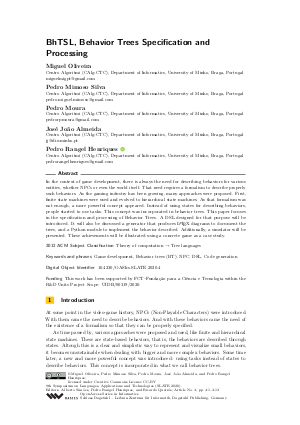BhTSL, Behavior Trees Specification and Processing
Authors
Miguel Oliveira,
Pedro Mimoso Silva,
Pedro Moura,
José João Almeida,
Pedro Rangel Henriques 
-
Part of:
Volume:
9th Symposium on Languages, Applications and Technologies (SLATE 2020)
Part of: Series: Open Access Series in Informatics (OASIcs)
Part of: Conference: Symposium on Languages, Applications and Technologies (SLATE) - License:
 Creative Commons Attribution 3.0 Unported license
Creative Commons Attribution 3.0 Unported license
- Publication Date: 2020-09-16
File

PDF
OASIcs.SLATE.2020.4.pdf
- Filesize: 0.52 MB
- 13 pages
Document Identifiers
Subject Classification
ACM Subject Classification
- Theory of computation → Tree languages
Keywords
- Game development
- Behavior trees (BT)
- NPC
- DSL
- Code generation
Metrics
- Access Statistics
-
Total Accesses (updated on a weekly basis)
0Document
0Metadata
Abstract
In the context of game development, there is always the need for describing behaviors for various entities, whether NPCs or even the world itself. That need requires a formalism to describe properly such behaviors. As the gaming industry has been growing, many approaches were proposed. First, finite state machines were used and evolved to hierarchical state machines. As that formalism was not enough, a more powerful concept appeared. Instead of using states for describing behaviors, people started to use tasks. This concept was incorporated in behavior trees. This paper focuses in the specification and processing of Behavior Trees. A DSL designed for that purpose will be introduced. It will also be discussed a generator that produces LaTeX diagrams to document the trees, and a Python module to implement the behavior described. Additionally, a simulator will be presented. These achievements will be illustrated using a concrete game as a case study.
Cite As Get BibTex
Miguel Oliveira, Pedro Mimoso Silva, Pedro Moura, José João Almeida, and Pedro Rangel Henriques. BhTSL, Behavior Trees Specification and Processing. In 9th Symposium on Languages, Applications and Technologies (SLATE 2020). Open Access Series in Informatics (OASIcs), Volume 83, pp. 4:1-4:13, Schloss Dagstuhl – Leibniz-Zentrum für Informatik (2020)
https://doi.org/10.4230/OASIcs.SLATE.2020.4
BibTex
@InProceedings{oliveira_et_al:OASIcs.SLATE.2020.4,
author = {Oliveira, Miguel and Silva, Pedro Mimoso and Moura, Pedro and Almeida, Jos\'{e} Jo\~{a}o and Henriques, Pedro Rangel},
title = {{BhTSL, Behavior Trees Specification and Processing}},
booktitle = {9th Symposium on Languages, Applications and Technologies (SLATE 2020)},
pages = {4:1--4:13},
series = {Open Access Series in Informatics (OASIcs)},
ISBN = {978-3-95977-165-8},
ISSN = {2190-6807},
year = {2020},
volume = {83},
editor = {Sim\~{o}es, Alberto and Henriques, Pedro Rangel and Queir\'{o}s, Ricardo},
publisher = {Schloss Dagstuhl -- Leibniz-Zentrum f{\"u}r Informatik},
address = {Dagstuhl, Germany},
URL = {https://drops.dagstuhl.de/entities/document/10.4230/OASIcs.SLATE.2020.4},
URN = {urn:nbn:de:0030-drops-130174},
doi = {10.4230/OASIcs.SLATE.2020.4},
annote = {Keywords: Game development, Behavior trees (BT), NPC, DSL, Code generation}
}
Author Details
- Centro Algoritmi (CAlg-CTC), Department of Informatics, University of Minho, Braga, Portugal
- Centro Algoritmi (CAlg-CTC), Department of Informatics, University of Minho, Braga, Portugal
- Centro Algoritmi (CAlg-CTC), Department of Informatics, University of Minho, Braga, Portugal
- Centro Algoritmi (CAlg-CTC), Department of Informatics, University of Minho, Braga, Portugal
Funding
This work has been supported by FCT-Fundação para a Ciência e Tecnologia within the R&D Units Project Scope: UIDB/00319/2020.
References
- Michele Colledanchise and Petter Ogren. Behavior Trees in Robotics and AI: An Introduction. Chapman & Hall/CRC Press, July 2018. URL: https://doi.org/10.1201/9780429489105.
-
Epic-Games. Behavior trees, 2020. Accessed: 2020-05-21.

- Ian Millington and John Funge. Artificial Intelligence for Games. Morgan Kaufmann Publishers, January 2009. URL: https://doi.org/10.1201/9781315375229.
-
Chris Simpson. Behavior trees for ai: How they work, 2014. Accessed: 2020-05-21.

-
Guillem Travila Cuadrado. Behavior tree library, 2018. Universitat Politècnica de Catalunya, Bachelor Thesis.

